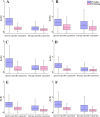Adaptive evolution driving the young duplications in six Rosaceae species
- PMID: 33563208
- PMCID: PMC7871599
- DOI: 10.1186/s12864-021-07422-7
Adaptive evolution driving the young duplications in six Rosaceae species
Abstract
Background: In plant genomes, high proportions of duplicate copies reveals that gene duplications play an important role in the evolutionary processes of plant species. A series of gene families under positive selection after recent duplication events in plant genomes indicated the evolution of duplicates driven by adaptive evolution. However, the genome-wide evolutionary features of young duplicate genes among closely related species are rarely reported.
Results: In this study, we conducted a systematic survey of young duplicate genes at genome-wide levels among six Rosaceae species, whose whole-genome sequencing data were successively released in recent years. A total of 35,936 gene families were detected among the six species, in which 60.25% were generated by young duplications. The 21,650 young duplicate gene families could be divided into two expansion types based on their duplication patterns, species-specific and lineage-specific expansions. Our results showed the species-specific expansions advantaging over the lineage-specific expansions. In the two types of expansions, high-frequency duplicate domains exhibited functional preference in response to environmental stresses.
Conclusions: The functional preference of the young duplicate genes in both the expansion types showed that they were inclined to respond to abiotic or biotic stimuli. Moreover, young duplicate genes under positive selection in both species-specific and lineage-specific expansions suggested that they were generated to adapt to the environmental factors in Rosaceae species.
Keywords: Adaptive evolution; Environmental stresses; Lineage-specific expansion; Rosaceae species; Species-specific expansion; Young duplication.
Conflict of interest statement
The authors declare that they have no competing interests.
Figures




Similar articles
-
Species-specific duplications driving the recent expansion of NBS-LRR genes in five Rosaceae species.BMC Genomics. 2015 Feb 14;16(1):77. doi: 10.1186/s12864-015-1291-0. BMC Genomics. 2015. PMID: 25759136 Free PMC article.
-
Functional requirements driving the gene duplication in 12 Drosophila species.BMC Genomics. 2013 Aug 15;14:555. doi: 10.1186/1471-2164-14-555. BMC Genomics. 2013. PMID: 23945147 Free PMC article.
-
Importance of lineage-specific expansion of plant tandem duplicates in the adaptive response to environmental stimuli.Plant Physiol. 2008 Oct;148(2):993-1003. doi: 10.1104/pp.108.122457. Epub 2008 Aug 20. Plant Physiol. 2008. PMID: 18715958 Free PMC article.
-
Evolution of Gene Duplication in Plants.Plant Physiol. 2016 Aug;171(4):2294-316. doi: 10.1104/pp.16.00523. Epub 2016 Jun 10. Plant Physiol. 2016. PMID: 27288366 Free PMC article. Review.
-
Evolutionary dynamics of duplicated genes in plants.Mol Phylogenet Evol. 2003 Dec;29(3):396-409. doi: 10.1016/j.ympev.2003.07.004. Mol Phylogenet Evol. 2003. PMID: 14615182 Review.
Cited by
-
Multi-tissue transcriptome analysis of two Begonia species reveals dynamic patterns of evolution in the chalcone synthase gene family.Sci Rep. 2021 Sep 7;11(1):17773. doi: 10.1038/s41598-021-96854-y. Sci Rep. 2021. PMID: 34493743 Free PMC article.
-
Recent Duplications Dominate VQ and WRKY Gene Expansions in Six Prunus Species.Int J Genomics. 2021 Dec 17;2021:4066394. doi: 10.1155/2021/4066394. eCollection 2021. Int J Genomics. 2021. PMID: 34961840 Free PMC article.
-
Evolution and functional analysis of the GRAS family genes in six Rosaceae species.BMC Plant Biol. 2022 Dec 6;22(1):569. doi: 10.1186/s12870-022-03925-x. BMC Plant Biol. 2022. PMID: 36471247 Free PMC article.
References
-
- Ohno S. Evolution by gene duplication. Berlin: Springer; 1970.
MeSH terms
LinkOut - more resources
Full Text Sources
Other Literature Sources

